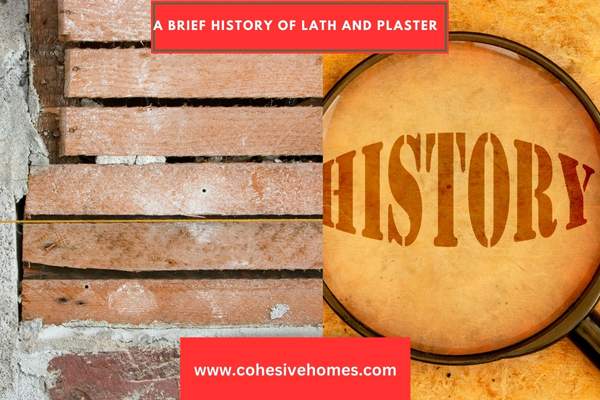If you’ve ever been curious about the age of your walls, lath and plaster could give you some insight. Before drywall and other modern construction materials became commonplace, lath and plaster were the go-to building materials. But when did people stop using this classic method to construct their walls?
If you’re a history buff, it likely won’t surprise you to learn that this building material has been around for centuries.
It’s estimated that the use of lath and plaster in construction can be traced back as far as ancient Greece. As recently as the 1950s, many homes in the Midwest still used it for interior walls.
This article will examine the point at which builders ceased using lath and plaster in construction. Additionally, we will explore the reasons why this traditional building material has been supplanted by more contemporary alternatives. Let’s begin!
Lath and plaster construction stopped being widely used in the mid-20th century, as it was replaced by more efficient and cost-effective building materials and techniques such as drywall.
A Brief History of Lath and Plaster

You may have heard of lath and plaster before, but what exactly is it?
Well, it’s a type of wall and ceiling construction that was popular in the United States until the mid-20th century.
To construct buildings using this technique, workers nailed wooden strips known as laths onto wooden studs.
The workers spread thin layers of wet plaster onto the laths, which formed a solid wall or ceiling.
It may come as no surprise that this type of construction was labor-intensive and time-consuming to complete; however, its durability and ability to resist moisture have helped keep lath and plaster in use for centuries.
Despite its strength, however, lath and plaster began falling out of popularity in the 1940s and 50s as more modern construction materials became available.
Today, you’re unlikely to find lath and plaster in homes or buildings—aside from some historical restorations—since newer materials provide a more efficient option for walls and ceilings.
While it may not be as popular as it used to be, the history of lath and plaster still plays an important role in architecture today.
How Lath and Plaster Are Constructed

Lath and plaster is an ancient technique that few still use today, but it still has a place in modern construction projects.
Lath and plaster walls, ceilings, and other objects are composed of laths, thin strips of wood nailed to the wooden framework, that are then covered in plaster.
The process begins by nailing the thin strips of wood (or laths) to the wooden framework in overlapping layers.
The overlapping layers create grooves that allow the plaster to settle into the wall instead of just sitting atop it.
Once these grooves are made, a wet mix of sand and lime putty is spread onto the laths with a trowel.
The combination of lath and mixed plaster gives strength to any object or wall.
Lath and plaster constructions were once commonplace for residential houses, churches, shops, and other types of buildings throughout Europe from medieval times until the early 20th century, when gypsum-based drywall became more widely used due to its lighter weight and faster installation process.
Ever since then, it has been slowly phased out as a mainstream building material for drywall and plasterboard options as we know them today.
Why Have Lath and Plaster Declined in Popularity?

You might be wondering why lath and plaster isn’t as popular as it once was.
Well, there are a few key reasons.
Cost
The cost of materials has been rising steadily since the 1970s and 1980s, when lath and plaster began to decline in popularity.
The cost of lumber and other materials needed for lath and plaster wall construction has become too expensive for many homeowners.
This isn’t the only factor that has caused its popularity to decline, however.
Labor
Laying the laths can take a lot of time because workers must nail or strap each piece of wood in place before applying the plaster.
In addition, applying multiple layers of plaster is a labor-intensive process that requires skill and patience to get right.
This all adds up to an expensive job, making lath and plaster a less attractive option than modern alternatives like drywall or concrete block walls.
Health and safety
In addition to being more costly to build, lath and plaster walls can present health hazards due to the use of materials like asbestos in older constructions.
Asbestos was commonly used in plaster as a fire retardant, but it can pose serious health risks if it is disturbed or damaged during renovation or demolition work.
For this reason, many people choose not to use lath and plaster construction methods any more.
Benefits of Lath and Plaster vs Modern Drywall

You might not expect it, but lath and plaster has some advantages over modern drywall.
And knowing the benefits of lath and plaster can help you decide whether it’s the right choice for your project.
Installing lath and plaster is a slower process than drywall, but it pays off in the end. Here’s why:
Acoustically Superior
One benefit of using lath and plaster instead of drywall is that it can be more acoustically superior.
Even though you may not realize it, buildings with poor acoustics sound quieter and more muffled because the walls absorb sound energy.
Lath and plaster walls allow sound to reverberate through the room, creating a warm, natural sound that is more pleasant for conversations or for playing music.
More Resilient
Lath and plaster walls also tend to be more resilient when compared to most types of modern drywalls since they are 2-3 times thicker than drywall, which is just an eighth of an-inch thick or thinner.
When someone bumps or pushes a lath and plaster wall inward, it will spring back into shape; drywall, on the other hand, tends to crack, crumble, or collapse under any impact force.
So if you’re looking for a more resilient option that also offers better acoustics, then you should consider lath and plaster for your project!
Challenges of Maintaining Lath and Plaster Walls

Lath and plaster walls have been in use for centuries, but the truth of the matter is that they’re not without their issues.
Periodic maintenance, repairs, and other measures are necessary to ensure that lath and plaster walls continue to perform as intended.
Keeping up with lath and plaster walls presents several challenges, including the following:
Repairs
The challenge with lath and plaster walls is that when problems do arise—like cracking, crumbling, or signs of water damage—it can be a real challenge to repair them.
Obtaining the materials for constructing lath and plaster walls can be difficult, and restoring the wall structure may require utilizing specialized skills.
Insulation Issues
Lack of proper insulation can lead to heat loss through thin layers of wall material, meaning you may have higher energy bills than expected from your living space.
To avoid this problem, homeowners need to add additional insulation, which can often require costly and intrusive renovations.
Moisture Damage
Another issue with lath and plaster walls is moisture damage.
These walls were built using materials that weren’t intended for modern living standards. Consequently, if excessive moisture infiltrates a lath and plaster wall, the homeowner may face expensive repairs like mold infestation or wood rot.
Because of these challenges, over time more homes began using drywall instead of lath-and-plaster construction due to its easier maintenance requirements.
By the 1960s, most homes had switched over completely, making drywall the go-to option for many home owners today.
Alternatives to Lath and Plaster Walls

An alternative to lath and plaster walls is drywall. We’ve all heard of this material, and that’s because it became popular in the 1950s, when the use of lath and plaster began to decline.
Drywall Benefits
The main benefit of drywall is that it’s much faster and easier to install than lath and plaster walls.
It typically takes just a few days to hang and finish a drywall wall, compared to weeks for lath and plaster—especially for more complex projects.
It also tends to be cheaper than its predecessors, too, since it does not require as many materials or specialized labor.
Other Alternatives
Besides drywall, some other alternatives to lath and plaster walls are plywood panels or cement-based sheathing boards.
Manufacturers create plywood panels by gluing thin layers of wood together in alternating directions, thereby producing a strong bond.
To produce cement-based sheathing boards, manufacturers mix wood particles with cement to form a durable and moisture-resistant material.
In conclusion, the popularity of lath and plaster as building materials has declined due to the replacement of modern materials like drywall, plywood panels, and cement-based sheathing boards.
These materials provide a faster installation process with less cost than lath and plaster walls while also providing more stability over time.
Conclusion

Builders have used lath and plaster for centuries, but the rise of drywall has made this traditional method of wall construction less popular in recent years.
Even though lathing and plastering is labor-intensive, builders still use this method extensively in historic structures and modern high-end homes.
Whether you’re a homeowner looking to preserve the history of your home or an experienced contractor looking for a unique and timeless wall finish, lath and plaster can be an effective and beautiful option.
Now that you know more about this traditional building material, you can make an informed decision about when and where to use it.
FAQS
When did lath and plaster stop being used?
Lath and plaster declined in popularity in the mid-20th century with the introduction of drywall.
Why did lath and plaster fall out of favor?
It was labor-intensive, prone to cracking, and less economical than modern construction methods.
Are there any advantages to using lath and plaster?
It is more soundproof and fire-resistant than drywall and can create unique finishes, but its cost, time, and maintenance requirements outweigh these benefits.
